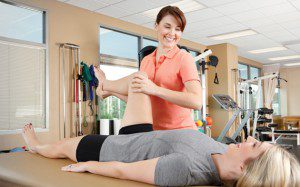By John C. Kagan, M.D. –


Joint surgery options may include minimally invasive surgical diagnosis and repair, also known as arthroscopic surgery. Arthroscopic surgery is a highly valuable tool in the diagnosis and repair of joint tears and joint inflammation. For instance, most meniscal tears in the knee can be treated successfully with arthroscopic surgery. Additionally, arthroscopy aids in the removal of inflamed linings (synovium) in knee, shoulder, elbow, wrist and ankle joints. Many patients have their arthroscopic surgery as outpatients and are home several hours after the surgery. With arthroscopic surgery oftentimes patients are able to go back to work or school within a few days of the procedure.
Rehabilitation for knee arthroscopy may include temporary immobilization in a cast or brace. Once the initial healing occurs, an exercise program to restore full mobility and strength is usually recommended. For those with knee arthroscopy, an orthopedic surgeon may recommend 20-30 minutes two or three times a day, along with a walking program as a part of the recovery process. The following exercises are a part of an initial exercise program that may be supervised by a physical therapist at the direction of a surgeon:
• Hamstring Contraction
No movement should occur in this exercise. Lie or sit with your knees bent to about 10 degrees. Pull your heels into the floor slowly towards your buttocks. Tighten the muscles of the back of your thigh. Hold five seconds and then relax. Repeat 10 times.
• Quadriceps Contraction
Lie on your stomach with a towel rolled under the ankle of the leg from your operated knee. Press the ankle down into the towel. Your leg should attempt to straighten as much as possible. Hold for five seconds and then relax. Repeat 10 times.
• Straight Leg Raises, Standing
Using support if needed, slowly lift your leg forward keeping your knee straight. Return back to standing and relax. Repeat 10 times.
Another common joint surgery is joint replacement, known as arthroplasty. Damaged bone and cartilage is removed and replaced with prosthetic components during arthroplasty surgery. This type of surgery typically results in a hospital stay for a few days and a longer recovery period. As with arthroscopic surgery, recovery time will reflect the individual’s type of surgery, as well as the plan set forth by their orthopedic surgeon for diet and exercise. In many cases, physicians will recommend that patients get in shape prior to the surgery. Cutting down or quitting smoking altogether, eating well and doing exercises to strengthen the body are customary recommendations. While hip and knee replacements are the most common types of joint replacement surgeries performed, other joint replacement surgeries may include ankle, foot, shoulder, elbows and fingers.
Early postoperative exercises are essential for hip or knee replacements. Patients are often encouraged to use their “new” joint shortly after surgery. Exercises can be done while in the hospital bed. Some include:
• Ankle Pumps
Slowly move your foot forward and back, out towards the wall in front of you and in towards your body. Repeat several times.
• Ankle Rotations
Move your ankle inward and rotate it outwards in clockwise circles. Repeat five times in each direction.
• Bed-Supported Knee Bends
Bend one knee as you slide your heel on the bed toward your buttocks. Do not let your knee roll inward.
• Straight Leg Raises
Tighten thigh muscle and straighten leg while lifting the leg off the bed several inches. Hold for five to 10 seconds and slowly bring leg back down to bed. Repeat the exercise until your thigh feels fatigued.
A physical therapist will typically visit a patient while they are in the hospital and begin providing direction on ways to mobilize the new joint. Some patients are even fitted with a continuous passive motion exercise machine that will help to slowly straighten and bend the joint replaced. Within three to six weeks following joint replacement surgery, most patients are able to resume normal light activities of daily living. Activity programs include graduated walking programs using a cane or a crutch inside the home and then outdoors and accomplishing household activities like climbing stairs. Full recovery can take many months so continuing with the prescribed home exercises is extremely important.
In all cases of joint surgery, restoring movement and strength while alleviating pain is the goal. If you are a candidate for joint surgery or are experiencing discomfort in your joints and are considering treatment options, know that while changes do not happen overnight, you can be proactive about your situation. Ensuring a successful outcome includes a commitment to finding the right treatment option for your condition, as well as committing to the healing process.
Dr. John Kagan has more than 30 years experience as an orthopedic surgeon treating patients in Southwest Florida. He specializes in treating patients with knee, shoulder and hip pain, as well as general orthopedics and hand surgery. For more information go to www.kaganortho.com
 Southwest Florida's Health and Wellness Magazine Health and Wellness Articles
Southwest Florida's Health and Wellness Magazine Health and Wellness Articles

